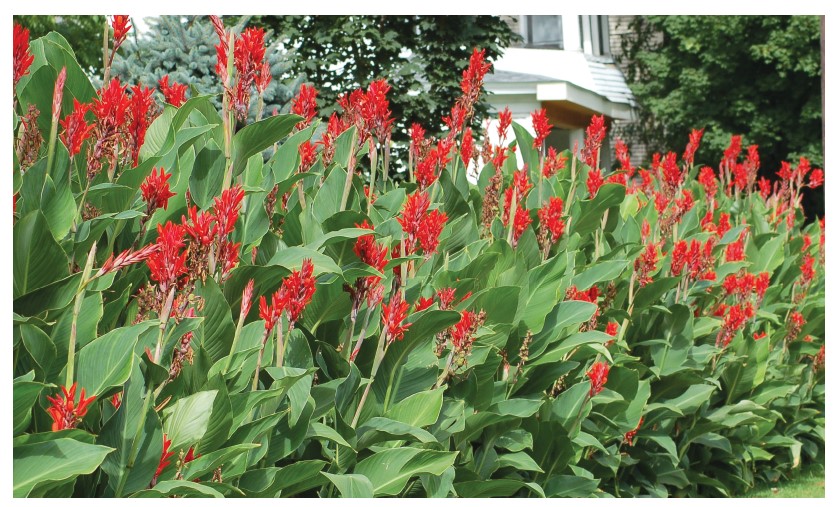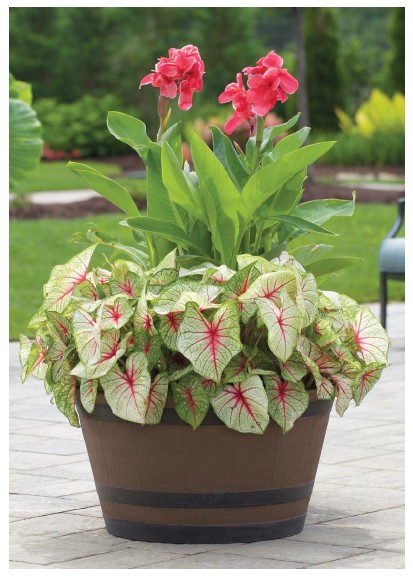For breathtaking drama and stately style, cannas should be a foremost consideration. With names like Lucifer (red flowers with yellow borders), Bengal Tiger (orange blooms with yellow and green striped foliage) and The President (scarlet blossoms), one may envision a vivid and spectacular landscape planted amass or as a single specimen focal point anchoring a circle-shaped garden.
Cannas will enhance any location with a look of tropical flair or Victorian elegance. They are prized for their multicolored combinations of yellow, orange, red, and pink lily-like blooms as well as their oversized, variegated foliage that boasts an almost stained glass-like appearance in a multitude of hues.

Cannas were among the earliest known domesticated plants and have been cultivated in Latin America and by Native Americans for thousands of years. All canna species can be traced to the Americas, affirming that the canna is an American genus that was spread around the tropics primarily as a valuable food source since the tubers are edible and a good source of arrowroot starch.
They are grown from rhizomes (tubers) planted four to five inches deep in full sun to part shade in moist, nutritious soil. Cannas need plenty of water and indeed do prefer wet feet; insufficient moisture will cause the foliage to tear or break. The large, soft leaves may be easily tattered in high winds so position in protected areas out of the wind where they might be less vulnerable.
While some nourishment is stored in the rhizomes, cannas also require and even crave a boost of balanced fertilizer during the growing season, especially when cultivated in containers. Pests are rare, although caterpillars may find the foliage a tasty treat and cause damage to the leaves.
 Featuring cannas in the home setting is effortless and straightforward. Flower beds and borders are enhanced by the bold foliage and brilliant flower spikes in late summer and early fall. Landscapes are augmented when cannas are used as a living hedge to define an entrance or to divide one garden area from another.
Featuring cannas in the home setting is effortless and straightforward. Flower beds and borders are enhanced by the bold foliage and brilliant flower spikes in late summer and early fall. Landscapes are augmented when cannas are used as a living hedge to define an entrance or to divide one garden area from another.
The use of cannas in strategically placed mega-planters or large containers can easily turn any vessel into a living work of art or a showy statement.
Varieties range in size from 18-36 inches as dwarf cultivars while the medium-sized specimens grow to 60 inches, and the tall varieties soar to a height well beyond that. These varying heights afford versatile landscaping options—containers, patios, backgrounds, borders, and massed plantings or garden clumps that include samplings of each height.
With their oversized glossy foliage and colorful blooms, cannas can add energy and interest to your home landscape with blooms that are fancied and sought after by butterflies and hummingbirds passing through on their migrations. Cannas feature a continuous growth and bloom pattern with no dormant periods, affording your garden color, appeal, and continued charm year-round.
The Award-Winning Canna Tropicanna Series
2002 Award of Merit (Britain and Holland)
In order to be named an “award-winner,” a plant should be more than beautiful. It must also prove that it is a consistent performer. The Canna Tropicanna Series has done just that. These award-winning plants are the ones that landscape professionals use when aspiring to create an impact, while home gardeners appreciate their no fuss, no challenges, and no drawbacks performance.
Try the original Canna Tropicanna with tangerine blossoms and striped red, pink, yellow, gold, and green foliage; or Tropicanna Black that sports scarlet-orange blooms and purple-black leaves. Another showstopper in this series is the Tropicanna Gold with green and gold striped leaves that are complimented by delicate orange flowers with yellow borders. With their shockingly beautiful blooms and foliage that is astonishing and exotic, these specimens stand out from all others.
Fun Facts About Cannas
- The rhizome is rich in edible starch.
- The stems and foliage are used as cattle feed.
- The young shoots are edible and can be eaten as a vegetable.
- The seeds make a purple dye and can be used to make jewelry.
- The seeds are sometimes added to tortillas.
- In India, cannas are fermented to make alcohol.
- In Thailand, cannas are a traditional Father’s Day gift.
- In Vietnam, canna starch is used to make noodles.
- In Guatemala, the leaves of the canna are used to wrap maize tamales.
- The fiber from the leaves is used to make light brown paper.